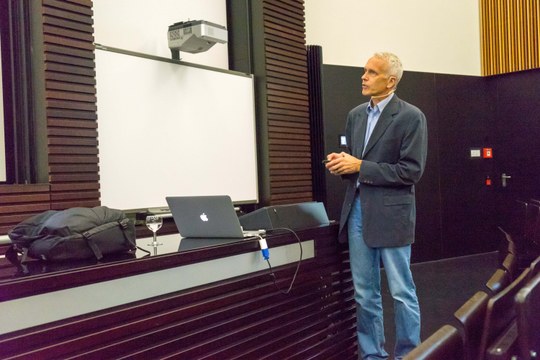19. Hermann Staudinger Lecture mit Nobelpreisträger Brian K. Kobilka
- Fehler
- Beim Anzeigen des Portlets ist es zu einem Fehler gekommen.
| Wann |
09.06.2015 von 18:15 bis 20:00 |
|---|---|
| Wo | Hörsaal Pathologie/Anatomie, Albertstr. 19 |
| Name | Dr. Britta Küst |
| Kontakttelefon | +49 (0)761 203-97418 |
| Teilnehmer |
öffentlich / open to public |
| Termin übernehmen |
|
Structural insights into the dynamic process of G protein coupled receptor signaling
G protein coupled receptors (GPCRs) conduct the majority of transmembrane responses to hormones and neurotransmitters, and mediate the senses of sight, smell and taste. The b2 adrenergic receptor (b2AR), the M2 muscarinic receptor and the mu-opioid receptor are prototypical Family A GPCRs. We have obtained three-dimensional structures of these receptors in inactive and active conformations, as well as a structure of the b2AR in complex with the G protein Gs.
Comparison of these structures provides insights into common mechanisms for propagation of conformational changes from the agonist binding pocket to the G protein coupling interface. We have also used fluorescence, EPR and NMR spectroscopy to study the dynamic properties of the β2AR. I will discuss what these studies have taught us about allosteric regulation of GPCR structure by G proteins and ligands.
Further information:
please klick on the picture below
Report on the 19th Hermann Staudinger Lecture with Brian Kobilka
Nobel Prize Laureate Professor Brian Kobilka from the Department of Molecular and Cellular Physiology at Stanford University School of Medicine was invited by the FRIAS for the 19th Hermann Staudinger Lecture. Brian Kobilka was awarded the Nobel Prize in Chemistry in 2012 together with Robert Lefkowitz for their groundbreaking “studies of G-protein-coupled receptors”.
G-protein-coupled receptors (GPCR) are chemical sensors in the cellular plasma membrane that transfer information from the outside into a cell. Brian Kobilka presented the fascinating history of his GPCR research from the pioneering cloning of adrenergic receptors to latest structural data. All this effort followed his main research goal “the understanding of GPCR activation and signaling”. In his talk he gave an excellent overview on the challenges he faced during the path to crystallize G-protein-coupled receptors in different conformations and the innovative approaches they invented to solve these issues. An early example was the cloning of the β2 adrenoreceptor gene 1986 in the lab of Robert Lefkowitz. To get structural data from these proteins was a long but in the end amazingly successful way. A main problem was the dynamic and flexible nature of GPCRs. It took him almost 20 years to get the first crystals with a resolution of 20 Å. While this was a major step, these first crystals did not provide the aimed resolution. Using protein engineering and stabilization of flexible intracellular loops by antibody fragments he succeeded to crystallize the β2 adrenoreceptor in the inactive state at a high resolution of 2.4 Å in 2007. In 2011 he determined the active Gs-coupled conformation of the β2 adrenoreceptor. Remarkably, an agonist was not able to fully stabilize the active conformation. To stabilize the active conformation he used nanobodies mimicking the Gs protein. Having these methods in hand he was also able to resolve the active and inactive structure of several other GPCRs including the muscarinic acetylcholine receptor M2 and the µ-opioid receptor. Using NMR-spectroscopy and DEER-spectroscopy he was able to identify the dynamics of these receptors illustrating that activation takes place in a quite conserved manner including outward movement of specific transmembrane domains. The audience highly appreciated this fascinating insight into function and dynamics of GPCRs reflected by a big round of applause.
Sebastian Preissl,
Institute of Pharmacology


